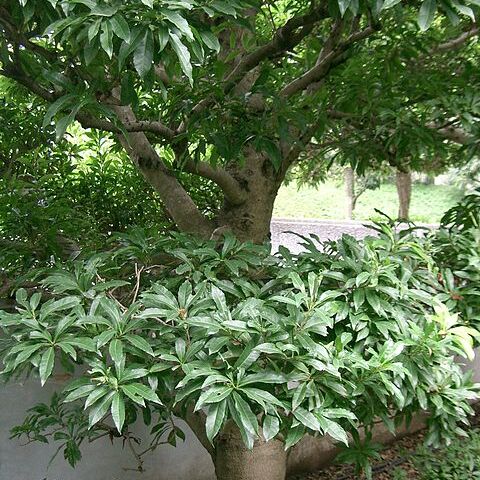Trees evergreen, dioecious, to 15 m tall; trunk to 60 cm d.b.h.; bark gray. Branchlets and buds glabrous. Petiole 2-10 mm, glabrous to puberulent adaxially; leaf blade cuneate-obovate ornarrowly elliptic-obovate, 5-14 × 1-4 cm, leathery, glabrous, abaxially pale green and sparsely to moderately golden glandular, adaxially dark green, base cuneate, margin entire or serratein apical 1/2, apex obtuse to acute. Male spikes simple or inconspicuously branched, solitary or sometimes few together in leaf axils, 1-3 cm; peduncle glabrous; bracts suborbicular, ca.1 mm, glabrous but abaxially golden glandular. Male flowers with 2-4 ovate bracteoles, sparsely ciliate. Stamens 4-6; anthers dark red, ellipsoid. Female spikes solitary in leaf axils, 0.5-1.5cm, many flowered; rachis pubescent and glandular; bracts overlapping, glabrous and inconspicuously glandular. Female flowers with 4 bracteoles. Ovary velutinous; stigmas 2, brightred, slender. Drupe dark red or purple-red at maturity, globose, 1-1.5 cm in diam., to 3 cm when cultivated, papilliferous; papillae to 3.5 mm. Fl. Mar-Apr, fr. May-Jul.
More
A tree. It is evergreen and has flowers of both sexes separately. It grows to 15 m tall. The trunk is 60 cm across. The bark is grey. The leaf stalk is 2-10 mm long. The leaf blade is narrowly oval and 5-14 cm long by 1-4 cm wide. They are leathery. They are dark green on top and pale green underneath. The base is wedge shaped and there can be teeth along the edge in the top half. The male flowering stalks are simple and mostly singly in the axils of leaves. They are 1-3 cm long. The female flowering stalks occur singly in the axils of leaves. They are 0.5-1.5 cm long. There are many flowers. The fruit is fleshy with a hard stone and is dark red or purple-red. It is round and 1-1.5 cm across but this can be 3 cm across in cultivated plants. The fruit are round and have one seed. The fruit are red and have a rough surface.
A tropical plant. It grows in tropical and subtropical Asia. It grows in forests in mountain slopes between 100-1500 m altitude. It can grow on poor soil. It can withstand wind, sea breeze and air pollution. It suits plant hardiness zone 10.
More
Forests of C. and S. Japan. Coastal districts in warm countries.
The fruit are eaten raw or cooked. They can also be eaten fresh, cooked, preserved or made into a drink. The seeds kernels are edible. The fruit are made into fruit wine or fruit brandy.

